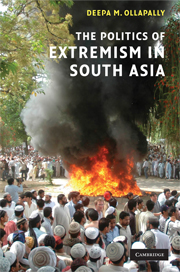Book contents
- Frontmatter
- Contents
- Acknowledgements
- Map of South Asia
- 1 Introduction: beyond and before the 9/11 framework
- 2 Situating violent conflict in South Asia
- 3 Afghanistan's changing fortunes
- 4 Pakistan at the crossroads
- 5 Conflict and contradiction in Kashmir
- 6 Sri Lanka's violent spiral
- 7 Bangladesh: divided politics and geopolitics
- 8 Conclusion
- Bibliography
- Index
5 - Conflict and contradiction in Kashmir
Published online by Cambridge University Press: 05 September 2012
- Frontmatter
- Contents
- Acknowledgements
- Map of South Asia
- 1 Introduction: beyond and before the 9/11 framework
- 2 Situating violent conflict in South Asia
- 3 Afghanistan's changing fortunes
- 4 Pakistan at the crossroads
- 5 Conflict and contradiction in Kashmir
- 6 Sri Lanka's violent spiral
- 7 Bangladesh: divided politics and geopolitics
- 8 Conclusion
- Bibliography
- Index
Summary
The demand by Kashmiri Muslims for greater autonomy burst into a full- fledged insurgency against the Indian government in 1989, and has kept the territory in the grip of violence ever since. The politics and actors involved have, however, hardly been constant. There have been numerous political and ideological formations in the interim, from parties that have held power as part of the Indian state to groups that are largely foreign. There are more facets to the Kashmir conflict than are often acknowledged, with local, national and regional forces affecting Kashmir's political developments.
The most important Kashmiri separatist umbrella organization, the All Parties Hurriyat Conference (APHC), ultimately split in 2004 on the issue of negotiating with the Indian government. The APHC sees itself as the main political representative of the Kashmiri militancy, but there are other armed groups that wield influence, such as the Hizb ul-Mujahideen. The Hurriyat itself defies easy characterization; as the political face of the militancy, its relationship with armed groups is ambiguous.
As in Afghanistan and Pakistan, the way in which competition between the three dominant identity constructions have occurred over time (religious, secular and geopolitical) tells us a great deal about the evolution of the militancy and the balance between moderate and extremist forces. An understanding of the prospects for resolving the conflict based on our findings is more important than ever given some of the powerful changes that have taken place regionally and within India since 2001.
- Type
- Chapter
- Information
- The Politics of Extremism in South Asia , pp. 114 - 144Publisher: Cambridge University PressPrint publication year: 2008



